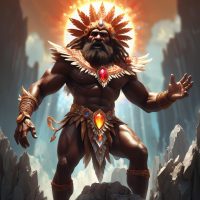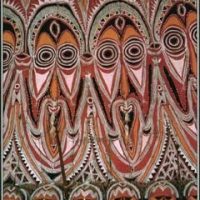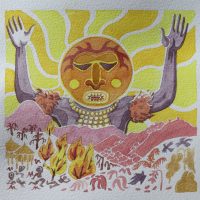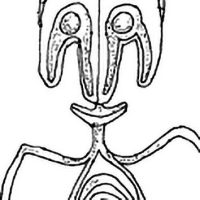Dudugera : The Sun God
Listen
At a glance
| Description | |
|---|---|
| Origin | Papuan Mythology |
| Classification | Gods |
| Family Members | N/A |
| Region | Papua New Guinea |
| Associated With | Sun |
Dudugera
Introduction
Dudugera holds a prominent place in Papuan mythology, often referred to as the “leg child” who ascended to become the sun. Within the cultural tapestry of the Melanesian people, Dudugera symbolizes the potent force and influence of the sun, albeit in a manner distinct from the benevolent depictions of typical sun deities. Rather, he embodies a more intricate persona, stemming from origins steeped in vengeance and wielding the scorching power inherent to the sun itself.
The specifics of Dudugera’s genesis vary across Papuan tribes and regions, yet a prevailing narrative centers on his unconventional birth. Legend has it that Dudugera’s existence began through an extraordinary event involving a woman interacting with a mysterious fish in the depths of the ocean. Following this encounter, the woman finds herself unexpectedly pregnant. In a startling twist, Dudugera emerges from a swelling on his mother’s leg, marking the commencement of his extraordinary journey and hinting at the remarkable destiny that awaited him.
Physical Traits
According to mythological accounts, Dudugera’s origins are rooted in an extraordinary tale of birth from a woman’s leg. This remarkable event transpired following an encounter where a woman engaged with a magnificent fish in the depths of the ocean. As a result of this interaction, the woman’s leg, upon which the fish had brushed against, began to swell until eventually birthing a baby. Dudugera, thus born, grew up within the village, though his aggressive demeanor rendered him unpopular among his peers.
Although depictions of Dudugera are somewhat limited, regional variations offer diverse portrayals of this enigmatic figure. Often depicted as a humanoid entity, Dudugera is imbued with the blazing intensity and brilliance synonymous with the sun itself. In certain narratives, he manifests as a fiery orb, emanating an overwhelming luminosity. Such representations serve as a poignant reminder of his fiery essence and the formidable power he commands.
Family
Information regarding Dudugera’s family is scant within the available sources. Nevertheless, his mother emerges as a central figure in his narrative, playing a pivotal role in his birth and upbringing. She is the one who gives birth to Dudugera following her interaction with a majestic fish, an event that shapes the course of his existence. Additionally, she assumes the role of protector, shielding Dudugera from harm and facilitating his transition to his father’s care when his aggressive demeanor alienates him from his community.
Dudugera’s familial background introduces a nuanced and intricate dynamic. While his mother serves as his immediate human connection, having borne him through her interaction with the fish god, it is Dudugera’s lineage with the ocean god that defines his true parentage. This dual heritage bestows upon him an innate affiliation with the boundless and primal forces of the sea. Consequently, Dudugera grapples with an internal conflict rooted in his dual identity, torn between the realms of mortal empathy and divine fury.
Other names
Throughout Papua New Guinea, Dudugera is known by a multitude of names, showcasing the rich cultural tapestry of the region. Among different tribes, he assumes various identities, each name offering a unique perspective on his essence. For instance, in some communities, he is referred to as “Auni,” a designation that translates to “the fiery one,” underscoring his affiliation with intense heat and power akin to the sun’s rays. Alternatively, in other cultural contexts, he is known as “Kamu,” a title connoting “the heat,” emphasizing the fear and awe he instills in those who encounter him. These diverse appellations serve to underscore Dudugera’s omnipresence and the profound impact he holds across different communities within Papua New Guinea.
Powers and Abilities
Dudugera harnesses the formidable power of the sun, though his association with it is tinged with malevolence. Often depicted as a harbinger of scorching heat and relentless drought, his influence is perceived as a dire affliction upon the world. Legend tells of Dudugera’s transition into the sun, during which he issued a warning to his mother and her kin, urging them to seek shelter beneath a towering rock. In a bid to mitigate the impending devastation, Dudugera’s mother intervened, thwarting total destruction by hurling lime into the sun’s face, thereby veiling the earth with protective clouds from its merciless rays.
Dudugera’s dominion over the sun grants him control over its searing heat and blinding light, enabling him to unleash devastating sunbeams and parching drought upon the land. Some accounts depict him as possessing the ability to shift between human and fiery forms, indicative of his mastery over transformation. His wrath is the stuff of legend, with tales recounting his use of scorching heat to mete out punishment upon humanity for their perceived transgressions.
Modern Day Influence
The mythology surrounding Dudugera, much like other revered deities in Papuan lore, plays a pivotal role in shaping the cultural identity of Papua New Guinea. These ancient tales serve as a mirror reflecting the people’s perception of the world and their position within it. Dudugera, revered as the sun god, embodies both the blessings and challenges inherent in the celestial bodies that govern the rhythm of life, impacting human well-being.
His visage graces traditional carvings and artworks, serving as a poignant reminder of the delicate equilibrium between the formidable forces of nature and human fragility. The enduring narrative of Dudugera is perpetuated through generations, serving as a constant beacon guiding communities toward a deeper understanding of their interconnectedness with the natural world. Through these timeless tales, communities are reminded of the paramount importance of reverence for nature and the imperative of harmonious coexistence with it.
Related Images
Frequently Asked Questions
What is lorem Ipsum?
I am text block. Click edit button to change this text. Lorem ipsum dolor sit amet, consectetur adipiscing elit. Ut elit tellus, luctus nec ullamcorper mattis, pulvinar dapibus leo.
What is lorem Ipsum?
I am text block. Click edit button to change this text. Lorem ipsum dolor sit amet, consectetur adipiscing elit. Ut elit tellus, luctus nec ullamcorper mattis, pulvinar dapibus leo.
What is lorem Ipsum?
I am text block. Click edit button to change this text. Lorem ipsum dolor sit amet, consectetur adipiscing elit. Ut elit tellus, luctus nec ullamcorper mattis, pulvinar dapibus leo.
What is lorem Ipsum?
I am text block. Click edit button to change this text. Lorem ipsum dolor sit amet, consectetur adipiscing elit. Ut elit tellus, luctus nec ullamcorper mattis, pulvinar dapibus leo.
What is lorem Ipsum?
I am text block. Click edit button to change this text. Lorem ipsum dolor sit amet, consectetur adipiscing elit. Ut elit tellus, luctus nec ullamcorper mattis, pulvinar dapibus leo.








